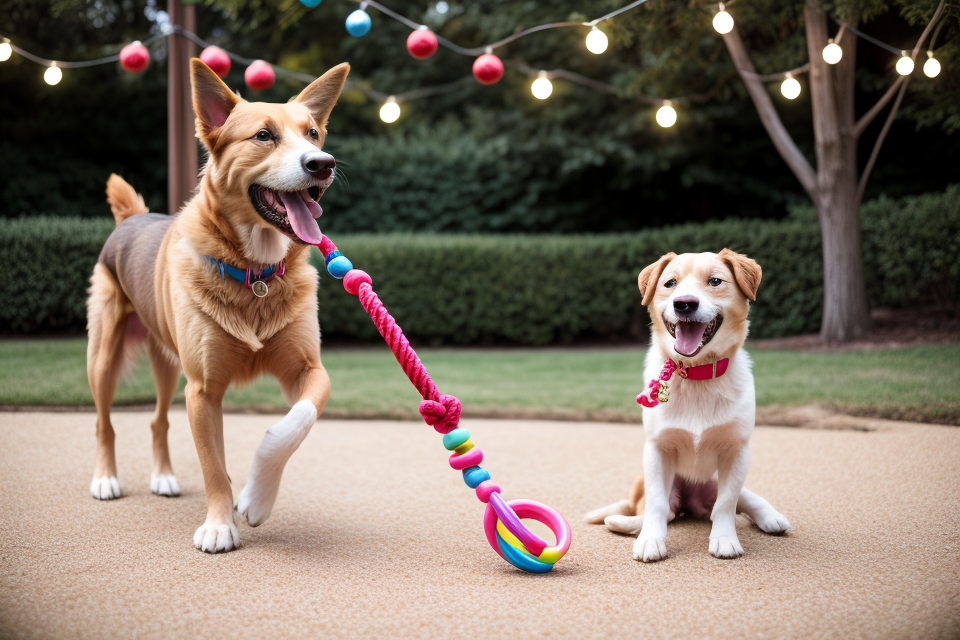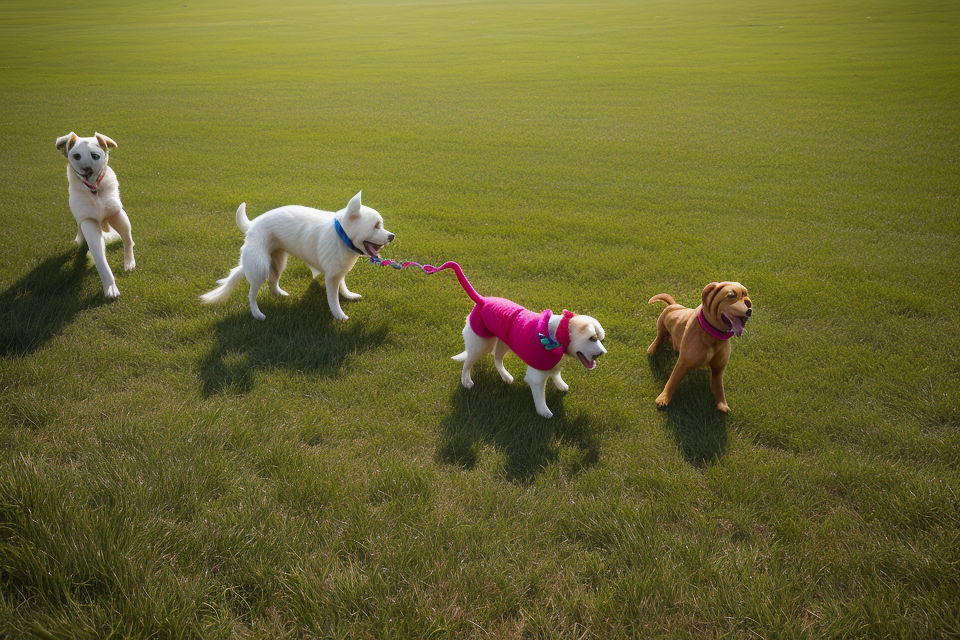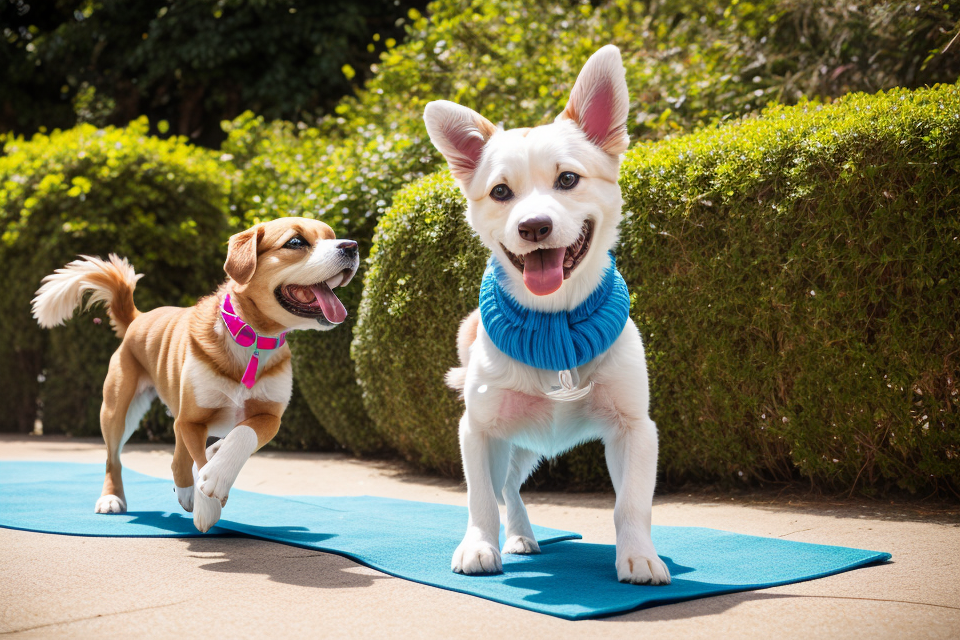Have you ever wondered why dogs love to play tug? It’s a question that has puzzled dog owners for centuries. But fear not, dear reader, because we are about to unleash the fun and explore the fascinating world of canine playtime.
From fetch to hide and seek, dogs have a natural instinct to play and interact with their environment. And when it comes to tug, there’s nothing quite like it. Whether it’s a soft toy or a rope, dogs just can’t get enough of pulling and tugging.
But why do they love it so much? Is it the thrill of the chase, the satisfaction of victory, or simply the joy of spending time with their beloved human? In this article, we’ll delve into the world of canine behavior and uncover the secrets behind why dogs love to play tug. So, grab your favorite furry friend and let’s get ready to play!
The Joy of Tugging: Exploring Canine Behavior
The Thrill of the Chase
Understanding the Instinct to Pursue
Dogs are known for their strong instinct to pursue and capture prey. This innate drive is deeply rooted in their wild ancestry, where hunting was crucial for survival. The thrill of the chase lies in their ability to utilize their sharp senses, agility, and endurance to track and catch their target.
A Natural Prey Drive
A dog’s prey drive is an essential aspect of their nature, and it plays a significant role in their behavior, both in the wild and in domestic settings. This instinct is triggered by movement, scent, or sounds that resemble potential prey. The pursuit of prey serves as an outlet for their energy, as well as a way to fulfill their natural hunting instincts.
The Role of Pack Dynamics
In a dog’s natural habitat, they often live in packs or groups, where they have a specific role to play. This social structure influences their behavior, as they are inclined to cooperate and communicate with one another when hunting. The thrill of the chase is intensified when dogs are able to engage in group hunting, as they can utilize their keen sense of smell and communication skills to work together as a team.
Overall, the thrill of the chase is an inherent aspect of a dog’s nature, rooted in their wild ancestry and pack dynamics. Understanding this instinct can provide valuable insights into a dog’s behavior and help owners appreciate the significance of playtime activities, such as tugging, in fulfilling their dogs’ needs and fostering a strong bond.
The Power of Play: Benefits for Dogs
Mental Stimulation
Dogs are known for their strong sense of smell, and they are able to use their sense of smell to find and track scents. This ability to smell and track scents is a result of their highly developed sense of smell, which is much more sensitive than that of humans.
Dogs have a powerful sense of smell, and they are able to use it to find and track scents. This ability to smell and track scents is a result of their highly developed sense of smell, which is much more sensitive than that of humans. Dogs have a large number of olfactory receptors in their noses, which allow them to detect a wide range of odors. This is why they are able to smell and track scents so well.
Dogs are also able to use their sense of smell to find food, and they are able to detect the slightest changes in the air. This ability to smell and track scents is what makes dogs such skilled hunters.
Dogs have a large number of olfactory receptors in their noses, which allow them to detect a wide range of odors. This is why they are able to smell and track scents so well. Dogs are also able to use their sense of smell to find food, and they are able to detect the slightest changes in the air. This ability to smell and track scents is what makes dogs such skilled hunters.
Sharpening Cognitive Skills
Playing tug with a dog can help to sharpen their cognitive skills. This is because the game requires the dog to use their problem-solving and planning abilities in order to win the tug of war. The dog must also use their memory and attention skills in order to anticipate the next move of their human opponent.
Playing tug with a dog can also help to improve their ability to learn and understand new commands. This is because the game requires the dog to listen and obey their human opponent in order to win the tug of war.
Problem-Solving and Planning
Playing tug with a dog can help to improve their problem-solving and planning abilities. This is because the game requires the dog to use their cognitive skills in order to win the tug of war. The dog must also use their memory and attention skills in order to anticipate the next move of their human opponent.
Investigating the Science Behind the Tugging Craze
The Neurological Aspects of Play
The Role of Dopamine
Dopamine, a neurotransmitter that plays a vital role in regulating emotions, motivation, and pleasure, is released during playtime. It reinforces the connection between positive experiences and specific behaviors, encouraging dogs to repeat actions that led to pleasure and satisfaction. In the context of tugging, the release of dopamine reinforces the dog’s desire to engage in this playful activity, making it an enjoyable and rewarding experience.
The Reward System
The reward system, a set of neural structures that involve dopamine release, is activated during play and tugging. When dogs engage in tugging, their brains perceive it as a rewarding experience, leading to the release of dopamine. This reinforces the behavior, encouraging dogs to continue playing tug and seek out similar activities.
The Connection to Pleasure and Satisfaction
The release of dopamine during play and tugging is directly linked to feelings of pleasure and satisfaction. Dogs experience a sense of happiness and enjoyment when engaging in these activities, which motivates them to participate in more play sessions and seek out opportunities for social interaction and physical exercise.
The Importance of Social Interaction
Social interaction plays a crucial role in a dog’s life, as it fulfills their innate need for companionship and communication. Playing tug provides dogs with opportunities to bond with humans and other animals, allowing them to form strong connections and establish relationships based on trust, love, and mutual respect.
Bonding with Humans and Other Animals
Tugging is a form of play that allows dogs to connect with humans and other animals on a deeper level. Through playful interaction, dogs can develop stronger bonds with their owners and other pets, creating a sense of security and trust that is essential for their overall well-being.
Learning Social Norms and Etiquette
Playing tug provides dogs with opportunities to learn social norms and etiquette. By engaging in this activity, dogs can learn how to communicate effectively, understand body language, and respect boundaries. This helps them develop good manners and improve their ability to interact with others in a positive and respectful manner.
Tugging Techniques: Tips for Handling and Training
The Art of Tugging: Techniques for Play
The Fetch and Tug Game
Tips for Playing Fetch with a Tug Toy
- Choose a suitable tug toy for your dog based on their size and strength.
- Start with short and close-range games to build trust and ensure your dog has control of the toy.
- Vary the location and environment to keep the game interesting and stimulating.
Training Your Dog to Release the Toy
- Use positive reinforcement to encourage your dog to release the toy.
- Reward your dog with treats, praise, or playtime for releasing the toy.
- Practice the “drop it” command in a non-play context to establish its meaning.
The Leash Tug Game
Teaching Your Dog to Tug on Leash
- Start with short and gentle tugs on leash to build your dog’s confidence and willingness to play.
- Gradually increase the duration and intensity of the tugging sessions.
- Use the “leave it” command to teach your dog to let go of the toy when playtime is over.
Tips for Safely Playing Leash Tug
- Ensure your dog is wearing a well-fitted collar or harness that allows for comfortable and safe tugging.
- Avoid playing tug on a slippery or uneven surface to prevent accidents or injuries.
- Keep an eye on your dog’s body language and behavior to ensure they are enjoying and tolerating the game.
Training Tips for Better Tugging Behavior
Training your dog to engage in tugging games can be a fun and rewarding experience for both you and your furry friend. By following these training tips, you can encourage better tugging behavior and strengthen the bond between you and your dog.
Positive Reinforcement
Positive reinforcement is a training technique that involves rewarding your dog for good behavior. When your dog engages in tugging games, be sure to praise them and give them plenty of treats and affection. This will encourage them to continue engaging in this behavior and associate tugging with positive experiences.
Rewarding Good Behavior
To effectively use positive reinforcement, it’s important to reward your dog for good behavior during tugging games. This could include things like taking breaks when requested, releasing the toy when told, or being gentle with the toy. The more you reward your dog for good behavior, the more likely they are to continue exhibiting those behaviors.
Clicker Training for Tugging
Clicker training is a type of positive reinforcement training that involves using a clicker sound to mark desirable behavior. To use clicker training for tugging, start by clicking the clicker as soon as your dog engages in the desired behavior. Then, immediately give them a treat and praise them. Over time, your dog will learn to associate the clicker sound with positive reinforcement and will be more likely to engage in the desired behavior.
Consistency and Patience
Consistency and patience are key when it comes to training your dog to engage in tugging games. It’s important to stick to a consistent training schedule and be patient with your dog as they learn and grow.
Sticking to a Training Schedule
Try to set aside dedicated time each day for training sessions. This will help your dog understand what to expect and will make training more effective. It’s also important to be consistent with your commands and expectations, so your dog knows what is expected of them during tugging games.
Dealing with Setbacks and Frustration
It’s natural for your dog to have setbacks and become frustrated during training sessions. If your dog becomes too excited or aggressive during tugging games, take a break and try again later when they are more calm and focused. It’s important to remain patient and consistent, even when faced with setbacks, as this will help your dog learn and grow over time.
The Joys of Playing Tug with Your Dog
Strengthening Your Bond
The Emotional Connection
Engaging in playful activities like tug-of-war with your dog can deepen your emotional connection. This shared experience allows you to understand your dog’s play style, body language, and preferences, enabling you to tailor future interactions for a more rewarding bond. By playing tug, you are demonstrating patience, trust, and affection, fostering a stronger relationship between you and your furry companion.
Building Trust and Confidence
Playing tug can also help build trust and confidence in your dog. As they learn to rely on you for direction and guidance during the game, they develop a sense of security and familiarity with their environment. This enhances their overall confidence, as they begin to understand that you will provide a safe and enjoyable experience. Additionally, as your dog becomes more comfortable with the game, they may show more enthusiasm and willingness to participate, further strengthening the bond between you and your pet.
Exploring New Adventures Together
Discovering New Activities and Games
Playing tug-of-war with your dog can open up a world of new adventures and games for both of you to enjoy. As you experiment with different styles of play, you may discover additional activities that your dog particularly enjoys, such as fetch, hide-and-seek, or scent work. Engaging in a variety of games not only keeps playtime interesting but also helps to stimulate your dog’s mind and body, preventing boredom and promoting physical and mental well-being.
Sharing Special Moments
Playing tug-of-war with your dog creates special moments that you can cherish together. These shared experiences foster a sense of togetherness and strengthen the bond between you and your pet. By taking the time to engage in playful activities, you are showing your dog that they are valued and loved, which can have a lasting impact on their overall well-being and happiness. As you continue to play tug and explore new games, you will create a treasure trove of memories that will last a lifetime, solidifying your unbreakable bond with your furry companion.
FAQs
1. Why do dogs like to play tug?
Dogs enjoy playing tug because it satisfies their natural instinct to chase, catch, and hold onto things. It’s also a fun and interactive way for them to bond with their owners and receive attention and affection. Additionally, playing tug can help satisfy a dog’s desire to use their mouth and teeth, which can help prevent destructive chewing behaviors.
2. Is playing tug safe for my dog?
Playing tug can be safe for your dog as long as you use appropriate toys and supervise the interaction. It’s important to choose toys that are designed for tugging and are made from durable materials that can withstand the force of your dog’s bites. Additionally, it’s important to make sure the toy is not too small or easily broken, which could pose a choking hazard.
3. How often should I play tug with my dog?
There is no set frequency for how often you should play tug with your dog, as it ultimately depends on your dog’s individual needs and preferences. Some dogs may enjoy playing tug daily, while others may only want to play occasionally. It’s important to observe your dog’s behavior and energy levels to determine how often they would like to engage in this activity.
4. What are the benefits of playing tug with my dog?
Playing tug with your dog can provide a number of benefits, including mental stimulation, physical exercise, and bonding opportunities. It can also help satisfy your dog’s natural instincts and prevent destructive behaviors. Additionally, playing tug can help improve your dog’s obedience and response to commands, as well as increase trust and confidence between you and your dog.
5. Can playing tug help with my dog’s behavioral issues?
Playing tug can be a helpful tool for addressing certain behavioral issues in dogs, such as aggression, anxiety, and destructive chewing. However, it’s important to note that playing tug alone may not be sufficient to address complex behavioral issues, and it’s always best to consult with a professional, such as a certified animal behaviorist, for personalized advice and guidance.



